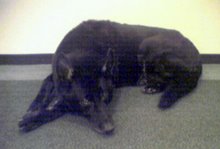Few people have seen a clouded leopard, named for its cloud-like spots. Its wild habitat in Southeast Asia. Although officially recorded as a species in 1821, the clouded leopard remains as mysterious today as it was nearly 200 years ago. Clouded leopards have the longest tail, in relation to body size, of any cat's tail. Also, their jaws can open wider than any other cat’s. Their 2-inch-long teeth are the same size as those of a tiger. Using their tail for balance, cloudeds ambush their prey from the treetops, landing on their target’s back and delivering one killing bite. Their flexible ankle joints allow them to climb down tree trunks headfirst. Cloudeds can climb upside down along branches and can hang by the back feet alone, which frees the front paws to snatch at prey.


More from the San Diego Zoo:
Growing up clouded
Like any newborn kitten, clouded leopard cubs are small and helpless at birth. Their eyes are closed, they have no teeth, and they are not able to walk. But at about two weeks of age their eyes open, and a week later the teeth start to emerge and they begin to walk on wobbly legs. By the time they are six months old they are fully weaned and have the full adult coloration.
Secretive lives
Considering its size, the clouded leopard is very secretive and has been difficult for researchers to study in the wild. It is believed the cats live solitary lives, unless a mother is caring for cubs. Never common, its population numbers are dropping outside of protected areas. Its rain forest habitat is often divided into small, unconnected patches of forest. As is true of all rain forest dwellers, the clouded leopards’ main threat to survival is continued habitat loss from a growing number of farms. And although they are protected by law, cloudeds are still hunted for their beautiful coat, and some Asian cultures believe clouded leopard bones and teeth have healing powers.
